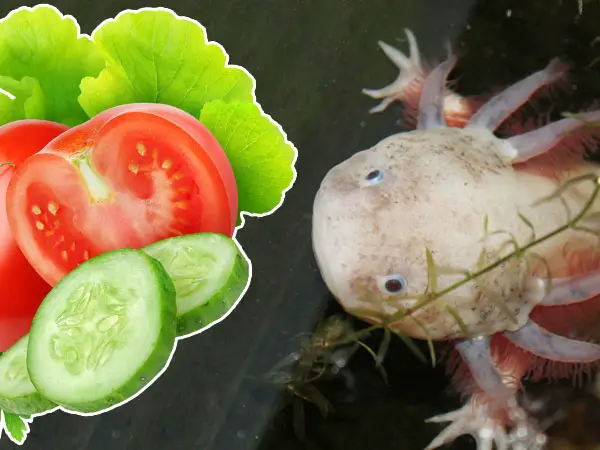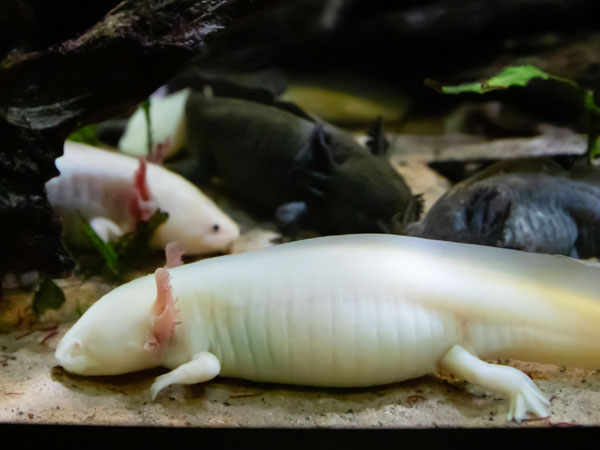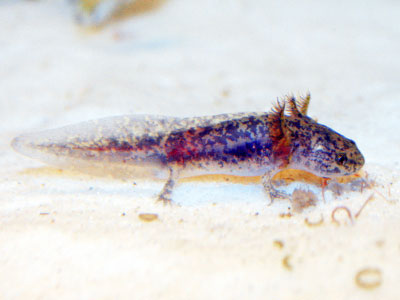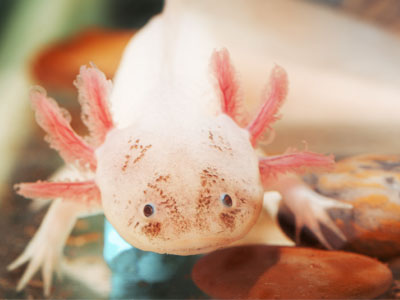
Keeping the aquarium water cool for axolotls is a big challenge for many that keep axolotls in home aquariums.
That’s because axolotls require cooler water temperatures and don’t do well in warm water conditions.
Cooling an axolotl aquarium becomes an even bigger challenge for those in warm climates where temperature spikes during certain months can spell trouble for axolotls.
Luckily, there are a few efficient ways to cool axolotl aquarium water that I’m going to discuss at length in this article.
What is the Ideal Temperature for Axolotls?
As I mentioned, axolotls thrive in colder temperature waters, they tolerate water in the 59-73 °F (15-23 °C) temperature range.
The ideal temperature for axolotls is 60-64 Fahrenheit (16-18 °C). It’s important to create water conditions that closely resemble the water conditions axolotls have access to in the wild.
Another important aspect is related to temperature stability. Maintaining stable water parameters is also important as fluctuations can expose axolotls to stress-induced diseases like infections.
Because the temperature range enjoyed by axolotls is on the lower end of the spectrum, it’s understandable that during the hot summer months, keeping temperatures from fluctuating is a bit difficult without the help of various water cooling techniques.
Why Should You Cool Your Axolotl Aquarium?
Having an aquarium cooling system in place is the only way to prevent sudden temperatures during the summer heat.
By being prepared and knowing what to do during times when temperatures rise, you’ll prevent inducing hyperthermia in your axolotls, which can be deadly to your axies.
You’ll also want to have a cool aquarium to mimic as closely as possible the conditions of the natural habitat of axolotls.
By having water at the temperature that axolotls are accustomed to in nature, you’re more likely to keep your pets healthy and potentially prolong their lifespan.
Many species also need a winter cooling period, which is useful for breeding in many species including axolotls.
How to Cool Water in Axolotl Tank?
Provided that you have an aquarium thermometer, you can monitor the water temperature in the tank and quickly notice if something isn’t right.
For axolotl aquariums, I recommend an aquarium thermometer that is installed on the aquarium and constantly measures both the temperature of the water and the temperature of the air.
Whether you want a quick fix or a permanent solution, here are all the ways you can cool axolotl aquarium water:
1. Installing an Air-Conditioning System
Whether you install one in the house or just the room where you keep your axolotl pets, an air conditioning system can certainly be an efficient way to keep the temperature from spiking during summer heat peaks.
Since water cools down slower than air, you will have to figure out how to set the temperature of your air conditioning system that it also efficiently cools down the water in the tank.
Having an accurate aquarium thermometer can help greatly in finding that temperature sweet spot that works for your axolotl and you.
2. Installing an Aquarium Cooling System
You may not want to install an air conditioning system in the room where you keep your axolotl, but you still want something to efficiently regulate the aquarium temperature.
In this case, you may need a cooling system dedicated for your aquarium. When it comes to aquarium chillers, there are two systems available — refrigerated aquarium chillers and thermoelectric aquarium chillers.
Refrigerated aquarium chillers work by a “heat exchange” process, whereby heat is removed from the water and transferred someplace else.
The aquarium chiller is made up of the following components: heat exchanger or evaporator, condenser coil, a compressor, and an expansion valve. It’s a more complex system that’s highly efficient, but also more expensive than a thermoelectric cooler.
Thermoelectric coolers operate based on the Peltier effect. With these types of chillers heat is absorbed through a probe sitting in the water, which transfers heat to a heat sink sitting above the tank. Heat is further drawn away from the heatsink with the help of a fan.
Thermoelectric chillers are cheaper, have fewer moving parts, but they’re really only efficient in tanks up to 10 gallons, anything larger than that requires the force of a refrigerated aquarium cooler.
3. Keeping the Tank in a Cold Room
Positioning your tank in a cool room (a room that is not exposed to direct sunlight) or the basement can offer some temperature relief.
Even within a room, you may find that placing the tank the floor as opposed to having it raised somewhere can make some difference in temperature.
4. Using Ice Bottles, Jugs or Ice Cubes
Ice cubes and ice bottles can work as a quick fix for when there’s a summer heat wave.
If you’re using ice cubes, make sure to prepare them with dechlorinated water and best to add them at night, after removing some water from the tank.
By placing these ice cubes into the tank at night, you’ll be replicating real-life conditions, of warm vs cool nights.
Ice bottles or jugs should also be filled with dechlorinated water in case they end up leaking into the water.
Have your ice bottle partially submerged into the aquarium and have an extra one in the freezer to switch back and forth between the bottles.
Make sure to closely monitor the temperature of the water to avoid any sudden changes.
5. Other Measures
There are multiple other things you can do to reduce the chances of water overheating in the aquarium or to better manage the influence of temperature spikes.
Here are some of the other aquarium cooling methods that can help cool the water in your axolotl tank:
- Increasing evaporation: By aiding evaporation, you can lower the temperature of the water by about 2 F (1 C). Using a screen top vs an aquarium hood is a simple change that can help decrease the temperature. An air stone placed into the tank or a filter with a spray bar can also be efficient. Using all these in conjunction with a fan over the tank or blowing directly on a wet towel wrapped around the tank will further decrease the temperature.
- Reducing the number of appliances/aquarium equipment: Remove any appliances from the room that give off excess heat (gaming PCs, gaming consoles, etc.). Review the aquarium equipment you’re using and see if you can replace them with others that don’t give off as much heat (e.g. incandescent lights vs fluorescent lights vs led lights). Even something as simple as installing the lights higher above the aquarium can go a long way in decreasing the temperature. Exchanging powerhead or motor-driven filters to bubble-driven ones, or simply lowering the wattage will also help with your cooling efforts.
- Insulating the aquarium: On its own, insulating the aquarium will not be of any help, but using insulating materials on the sides of the tank while also employing other cooling methods will increase the efficiency of all your other efforts.
DIY Aquarium Cooling Ideas
If you’re open to experiment and you don’t shy away from fashioning your own cooling system, here are some ideas to get you started:
- You can use a ready-made clip-on aquarium fan, but you can also repurpose a small computer fan to double as an aquarium fan. With a little wiring to make the computer fan plug into a household electrical socket, you can have an aquarium fan to help with evaporation.
- If you have a screen lid instead of an aquarium hood, you can further help evaporation with a simple household fan.
- If you have a water cooler at home, you can create your own aquarium cooling system with a pump, water tubes and a reservoir to prevent overflowing of excess water.
- Another homemade cooling device that you can probably create with materials you have at home is the ice water cooler, which needs a pump or canister filter, a cooler containing ice water and tubing. The idea is to get the water pass through the ice water to cool it down. You’ll need lots of ice and you’ll need to replenish the ice 1-2 a day.
Whether you’ll go with ready-made solutions or you’ll try to make your own cooling system, one thing is certain — you’ll have to make sure that your axolotls are comfortable with whatever cooling system you use and that their water is kept at a stable temperature even during the summer heatwave.
Conclusion
Axolotls enjoy colder temperature water, which means that when temperatures rise in your home, you must be prepared to keep the water in the aquarium from overheating.
Aquariums can overheat even if outside temperatures are within the normal range for axolotls simply by having too many equipment in or around the aquarium that give off heat.
Whether you live in a hot climate zone or a summer heat wave is approaching in your area, you must be prepared either by investing in a professional aquarium chiller or fashioning one yourself.
I hope the tips to cool axolotl aquarium water I discussed in this article will also help you keep your axolotls safe and sound when temperatures peak.




